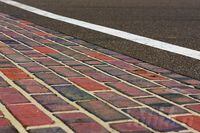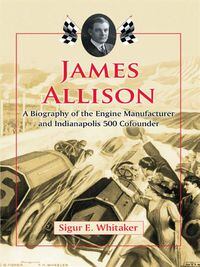The Indianapolis Motor Speedway is often called “The Brickyard” because brick paving, begun in October, 1909, looked like the best and safest alternative to the oiled crushed rock used earlier. This information comes from Sigur Whitaker’s biography of James Allison, one of the four partners who originally brought The Speedway into being.
There had been several crashes during the program of races that took place August 19, 1909. The fifth race of the day was the 250-mile Prest-O-Lite trophy. “With the surface breaking up badly in places,” notes Whitaker, “particularly in the turns, officials from the American Automobile Association were very concerned about the condition of the track.” After two more days of serious racing mishaps, it was rumored “that there would be no more racing at the Indianapolis Motor Speedway.”
Two possible “fixes” were concrete—the pavement chosen for Britain’s great Brooklands Speedway—or brick, as neither of these would break up in summer heat under the pounding and sliding of tires. The choice was 30 million pounds of bricks, set on two inches of sand, rolled and then grouted with a concrete mixture.
Although the track would eventually be paved with modern tarmac, bricks enabled the early Speedway to realize the ambitions of its creators: to make the track financially successful and to contribute to the development of motor vehicles.


/cloudfront-us-east-1.images.arcpublishing.com/octane/EHHGX7WY6REFLFPN4LWXVC2QP4.jpg)
/cloudfront-us-east-1.images.arcpublishing.com/octane/YNGKWQRUMJEVLL5HTPPAEHIUQA.jpg)
/cloudfront-us-east-1.images.arcpublishing.com/octane/MB5GFVVTBVFY3PFOAQH5CLZTYM.jpg)
/cloudfront-us-east-1.images.arcpublishing.com/octane/R26K447HPJFXNL7HDNAIY4VOI4.jpg)
/cloudfront-us-east-1.images.arcpublishing.com/octane/U3S3JPJT5REW7NTPZMUP2FZY3A.jpg)
/cloudfront-us-east-1.images.arcpublishing.com/octane/WPQ2LXEKPVFZRF2CZLPSDOMVAI.jpg)
/cloudfront-us-east-1.images.arcpublishing.com/octane/BNSDRE4DCJE5ZPOLGPBZPOMZEI.jpg)
/cloudfront-us-east-1.images.arcpublishing.com/octane/GO6FSVIIKNBVPLSIS7IBWE7AEM.jpg)
/cloudfront-us-east-1.images.arcpublishing.com/octane/CS6TMZNTENGKFDW56HSE2HFZ2M.jpg)
/cloudfront-us-east-1.images.arcpublishing.com/octane/FUFID44YDBAM3EHF2AV5LDHLVE.jpg)
/cloudfront-us-east-1.images.arcpublishing.com/octane/QKEXZXUGVFATPE7RAT3HAHDQZ4.jpg)
/cloudfront-us-east-1.images.arcpublishing.com/octane/T7GEMBOUDBHX7EDP2PRQ2J2XME.jpg)
/cloudfront-us-east-1.images.arcpublishing.com/octane/U4CKRUKLKZD43FDSDLZHBL7YVA.jpg)
/cloudfront-us-east-1.images.arcpublishing.com/octane/OFSXJJ5PZFEZ5D5ZPMCFVHJUMA.jpg)
/cloudfront-us-east-1.images.arcpublishing.com/octane/N2JLNLG44VEKBMEPORRDTMX5A4.jpg)
/cloudfront-us-east-1.images.arcpublishing.com/octane/PYWEGG6FHJD6XLPKICS7XHMMZ4.jpg)
/cloudfront-us-east-1.images.arcpublishing.com/octane/XXFQQQ4AYJDCXDGVW3JTHAYONI.jpg)
/cloudfront-us-east-1.images.arcpublishing.com/octane/WMF36OICPZEJDPKABMHQVHXBZ4.jpg)
/cloudfront-us-east-1.images.arcpublishing.com/octane/3DJ46QYFAJA5RIJILQR2XIZXM4.jpg)
/cloudfront-us-east-1.images.arcpublishing.com/octane/4HYMMY6K4JHMNEQ56FXTGAHKG4.jpg)
/cloudfront-us-east-1.images.arcpublishing.com/octane/KUENZXA3RFBIHIDGHEEVH6YNYE.jpg)
/cloudfront-us-east-1.images.arcpublishing.com/octane/UW6THULV65E4TDI4DWLOMDR7LY.jpg)
/cloudfront-us-east-1.images.arcpublishing.com/octane/5S5CDZTZPJBHJBLHENVXEFYKG4.jpg)
